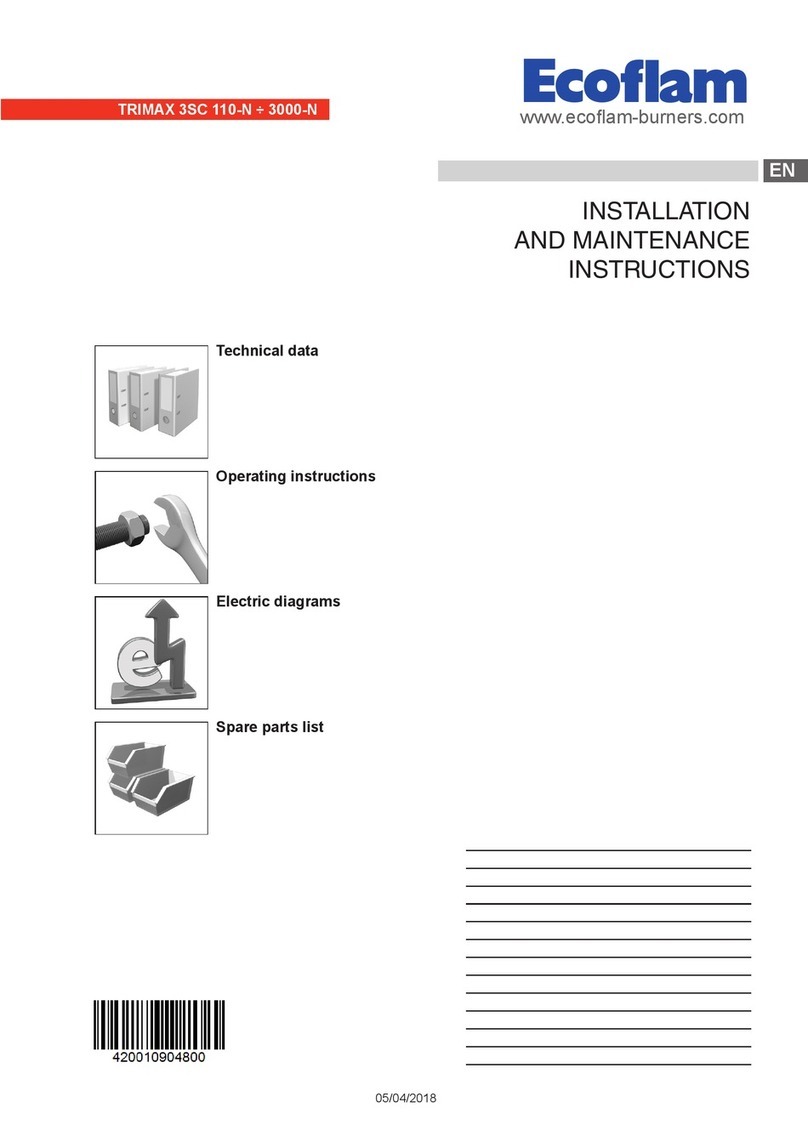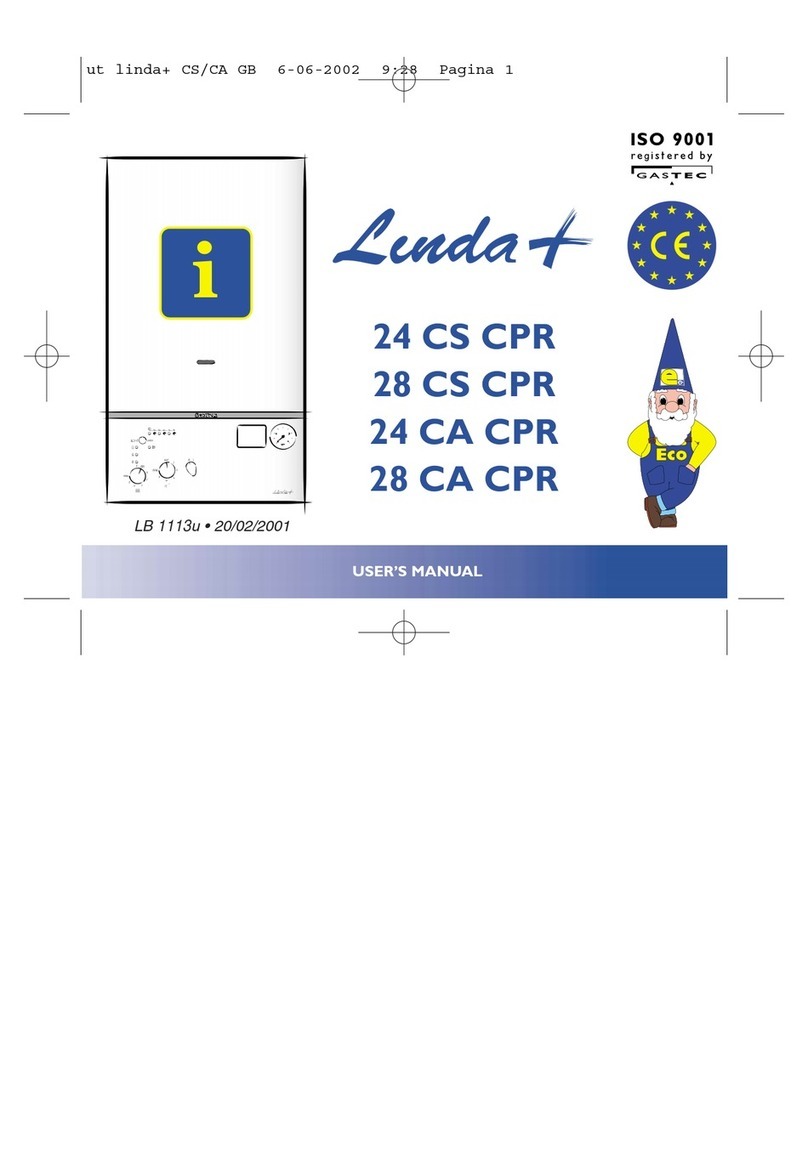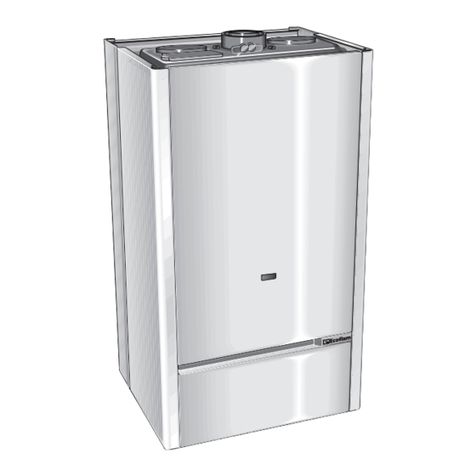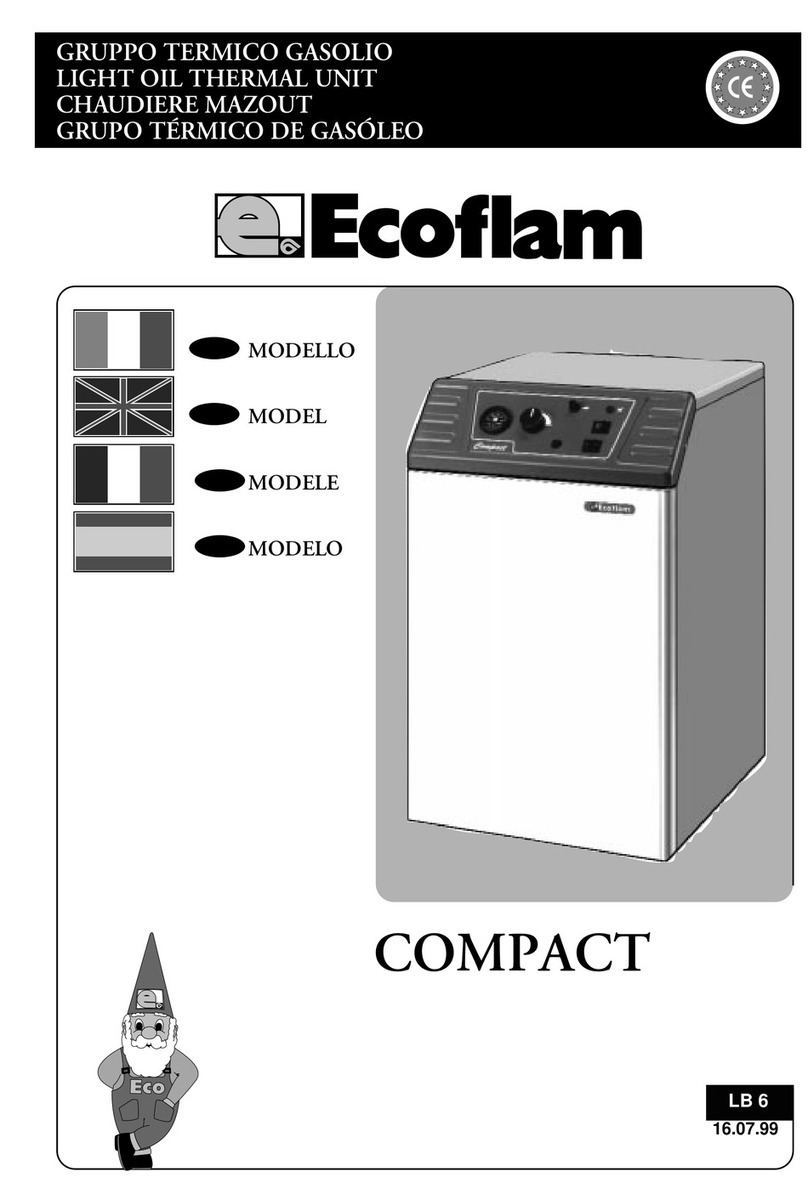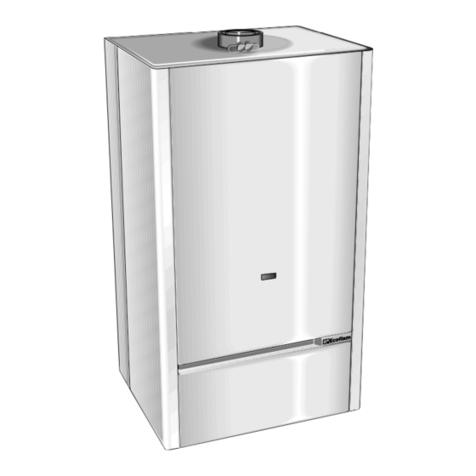
EGBI
62 -7-
DESY
ATTENZIONE
L'installazione, la prima accensione, le
regolazioni e le operazioni di manutenzione
devono essere effettuate, secondo le istru-
zioni, esclusivamente da personale qualifica-
to. Un'errata installazione puòcausare danni
a persone, animali o cose, nei confronti dei
quali il costruttore non èconsiderato respon-
sabile.
AVVERTENZE PER L'UTENTE
Per poter sfruttare al meglio questo gruppo ter-
mico, vi diamo alcuni consigli utili per il suo uso
e manutenzione:
- Controllare periodicamente la pressione del-
l’impianto sull’idrometro e verificare con impian-
to freddo che la pressione abbia un valore tra
0,7 e 1,5 bar (7 e 15 m H20).
Se la pressione èal di sotto del valore minimo,
ènecessario ripristinarla per mezzo del rubi-
netto di riempimento posto nella parte inferio-
re della caldaia.
Una volta raggiunto il valore medio di 1 bar
(10mH20) richiudere bene il rubinetto.
Se il calo di pressione èmolto frequente èpro-
babile che ci sia una perdita d’acqua nell’im-
pianto. In questo caso ènecessario l’interven-
to del Vostro installatore.
- La pulizia della pannellatura deve essere fatta
solamente con acqua saponata.
- Nel caso in cui la durezza dell’acqua sia ec-
cessiva, inserire piccoli addolcitori in modo che
il rendimento rimanga inalterato nel tempo fa-
cendovi consumare meno gas.
- Per un maggiore comfort e per un piùraziona-
le utilizzo del calore èconsigliabile installare
un termostato ambiente abbinato eventualmen-
te ad un orologio programmatore per le varie
accensioni e spegnimenti nell’arco della gior-
nata (o settimana).
- Nel caso di non utilizzo prolungato della cal-
daia togliere tensione portando l’interruttore ac-
ceso/spento "H" in posizione <O> e chiudere
il rubinetto del gas esterno alla caldaia.
- Se sussistono probabilitàche nell'ambiente in
cui èinstallato l'apparecchio, la temperatura
possa scendere al di sotto dello zero e in par-
ticolare se si prevede di non utilizzare l'appa-
recchio quotidianamente, ènecessario svuo-
tarlo di tutta l'acqua contenuta.
- Programmare in tempo con il centro assisten-
za autorizzato la manutenzione annuale della
caldaia.
IMPORTANTE!
Controllare che siano rispettate le disposi-
zioni relative all'entrata dell'aria ed alla ven-
tilazione del locale in cui èinstallata la cal-
daia.
ATENCION
La instalación, el primer encendido, los ajustes
y las operaciones de manutención deben ser
efectuadas, según las instrucciones,
exclusivamente por parte de personal
calificado. Una instalación errónea puede cau-
sar daños a personas, animales o cosas ante
los cuales el constructor no es responsable.
ADVERTENCIAS PARA EL USUARIO
Para poder usufruir en el mejor modo posible
de este equipo térmico le damos algunos
consejos útiles para su uso y manutención:
- Controlar periódicamente la presión de la
instalación en el manómetro y verificar con la
instalación fría que la presión tenga un valor
entre 0.7 y 1.5 bar (7 y 15m H20).
Si la presión se encuentra por debajo del valor
mínimo, es necesario restablecer los valores
normales por medio de la válvula de llenado
ubicado en la parte inferior de la caldera.
Una vez alcanzado el valor medio de 1 bar (10m
H20) volver a cerrar bien la llave. Si la baja de
presión es muy frecuente es probable que exista
una pérdida de agua en la instalación. En este
caso es necesaria la intervención de su
instalador.
- La limpieza de los paneles de rivestimiento debe
ser efectuada solamente con agua enjabonada.
- En el caso de que la dureza del agua sea
excesiva, introducir suavizadores de agua
pequeños en modo que el rendimiento quede
inalterado en el tiempo permitiéndole un menor
consumo de gas.
- Para un mayor confort y para el utilizo mas
racional del calor es aconsejable instalar un
termostato ambiente unido eventualmente a un
reloj programador para los varios encendidos y
apagados del día (o la semana).
- En el caso de que no se prevea la utilización de
la caldera por un período prolongado quitar la
corriente situando el interruptor encendido/
apagado "H" en posición <O> y cerrar la llave
de gas externa de la caldera.
- Si existen probabilidades de que en el ambien-
te en el cual estáinstalado el aparato, la tem-
peratura pueda disminuir por debajo del cero y
en particular si se prevee de no utilizar el aparato
cotidianamente, es necesario vaciarlo de toda
el agua contenida.
- Programar con tiempo con el Centro de
Asistencia Autorizado la manutención anual de
la caldera.
¡IMPORTANTE!
Controlar que sean respetadas las
disposiciones referentes a la entrada del aire
y la ventilación del local en el cual se
encuentra instalada la caldera.
CAUTION
Installation, startup, adjustments and
maintenance must be performed by qualified
personnel only in accordance with the
instructions provided. Improper installation
may cause damage or injury to individuals,
animals and personal property, for which the
manufacturer will not be held liable.
INSTRUCTIONS FORTHE USER
To get the most out of your boiler unit, we have
provided you with some useful advice on proper
use and maintenance:
- Periodically check the system pressure with
the pressure gauge and make sure that the
pressure is betwen 0.7 and 1.5 bar (7 and 15
m H20) when the system is off and cool.
If the pressure is below the minimum
recommended value, the pressure must be
brought into the acceptable range using the
water inlet valve located on the bottom part of
the boiler.
Once the median value of 1 bar (10m H20) has
been reached, close the inlet valve.
If the pressure level drops on a frequent basis,
it is likely that there is a water leak in the
system. If this is the case, your installer must
inspect the unit.
- The outer panels of the unit's shell must only
be cleaned with soapy water.
- If the water is exceptionally hard, install small
softeners so that the efficiency of the unit
remains the same over time, as this will
consume less gas.
- To improve comfort and take full advantage of
the heat produced by the boiler, it is
recommended that an external thermostat be
installed. A programmable timer for the
thermostat is also recommended to schedule
when the boiler will turn on and off during the
course of the day (or week).
- If the boiler is not going to be used for an
extended period of time, turn off the supply of
electricity to the unit by turning the On/Off
switch (H) to "O". Then turn off the supply of
gas to the unit itself.
- If the boiler is not going to be used on a daily
basis and it is probable that the ambient tem-
perature will drop below zero, the unit must be
drained of water.
- Schedule annual maintenance inspections with
an authorized service centre in a timely
manner.
IMPORTANT!
Make sure that the instructions regarding air
inlets and ventilation of the room in which
the boiler is installed have been complied with
in full.

